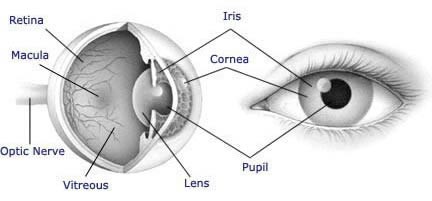Diabetic Eye Disease
Diabetes mellitus (sugar diabetes) affects the eyes in several ways.
During episodes of high blood sugar levels, the lens inside the eye can swell, causing blurry vision. This is usually a transient phenomenon that resolves once blood sugars have normalized, but may take several weeks to return to normal.
Elevated blood sugar levels, over time, can cause damage to the cells that form the lining of the small blood vessels throughout the body. These damaged blood vessels work less effectively and lead to a number of changes, which are usually asymptomatic in the initial stages, but can be seen by us during your eye exam.

Initial damage can be seen as small outpouchings of the blood vessels (microaneurysms), leakage of proteins from the blood vessels into the surrounding tissues (exudates), small hemorrhages, and swelling of the retinal layers (macular edema). When these changes are present, we call this Non-Proliferative Diabetic Retinopathy, and grade this mild, moderate, or severe depending on the amount and location of changes.
As damage continues, chemicals are released by the nutrient-deprived cells, which cause new blood vessels to grow. This stage is called Proliferative Diabetic Retinopathy, and is divided into high- and low-risk categories. New blood vessels tend to grow in a disorderly pattern, and if left untreated, can cause retinal detachment and blindness.
Treatment of diabetic retinopathy is focused on prevention. Good blood sugar control is the most important step towards preventing diabetic eye disease. Annual eye exams are recommended for all diabetic patients to screen for the changes mentioned above, as symptoms only occur during the late stages of the disease.
As diabetic retinopathy progresses, laser treatment may be necessary to prevent further progression of the disease. Diabetic retinopathy is the leading cause of blindness for patients between the ages of 20 and 64.
Diabetics are also at higher risk for developing glaucoma, a disease in which progressive damage to the optic nerve causes loss of peripheral vision. Patients with glaucoma often experience no symptoms until vision loss has occurred. An annual eye exam is recommended to screen for the presence of glaucoma.
Finally, diabetics also tend to develop cataracts earlier than non-diabetics. Cataract is the term used to describe the aging process of the lens inside the eye. As you age, the lens becomes cloudy due to years of metabolism and ultraviolet light exposure, which in turn leads to decreased quality of vision. As cataracts develop, new glasses may be required. Once glasses no longer improve vision, surgery to remove the cloudy lens may be indicated.
